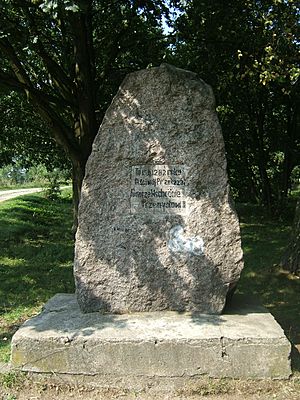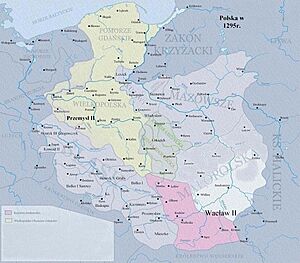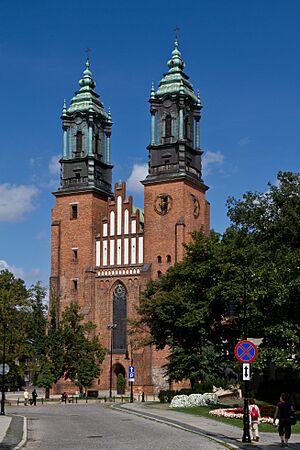Przemysł II facts for kids
Quick facts for kids Przemysł II |
|
|---|---|
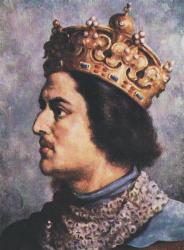 |
|
| King of Poland | |
| Reign | 1295–1296 |
| Coronation | 26 June 1295 at Gniezno Cathedral |
| Predecessor | Bolesław II the Generous |
| Successor | Wenceslaus II |
| High Duke of Poland | |
| Reign | 1290–1291 |
| Predecessor | Henryk IV Probus |
| Successor | Wenceslaus II |
| Duke of Greater Poland | |
| Reign | 1279–1296 |
| Predecessor | Przemysl I |
| Successor | Władysław I the Elbow-high |
| Born | 14 October 1257 Poznań, Kingdom of Poland |
| Died | 8 February 1296 (aged 38) Rogoźno, Kingdom of Poland |
| Burial | at Archcathedral Basilica of St. Peter and St. Paul, Poznań |
| Spouse |
|
| Issue | Elizabeth Richeza, Queen of Bohemia |
| House | Piast dynasty |
| Father | Przemysł I of Greater Poland |
| Mother | Elisabeth of Wrocław |
| Religion | Roman Catholic |
Przemysł II (born October 14, 1257 – died February 8, 1296) was an important Polish ruler. He was the Duke of Poznań from 1257, then of Greater Poland from 1279. He also ruled Kraków for a short time (1290–1291) and Gdańsk Pomerania (Pomerelia) from 1294. In 1295, he became the King of Poland.
After a long time without a true king, Przemysł II was the first to gain the royal title that could be passed down through his family. This brought Poland back to being a kingdom. He was part of the Piast dynasty. His father, Duke Przemysł I of Greater Poland, died before he was born. So, his uncle, Bolesław the Pious, raised him. Przemysł II started ruling his own area, the Duchy of Poznań, in 1273. Later, he also got the Duchy of Kalisz.
At first, Przemysł II focused on local matters, working with and sometimes against Duke Henryk IV Probus of Wrocław. He worked with Archbishop Jakub Świnka of Gniezno to try and unite the different Polish lands. In 1290, Henryk IV Probus unexpectedly left him the Duchy of Kraków, which came with the title of High Duke of Poland. However, Przemysł II didn't have enough support from the local nobles. Also, King Wenceslaus II of Bohemia was becoming a big threat. So, Przemysł II decided to leave Lesser Poland.
In 1293, Archbishop Jakub Świnka helped him form a strong alliance with other Polish dukes, Władysław I the Elbow-high and Casimir II of Łęczyca. Their goal was to get Kraków back from King Wenceslaus II.
When Duke Mestwin II died in 1294, Przemysł II inherited Pomerelia, as agreed in the Treaty of Kępno in 1282. This made him much stronger. He was crowned King of Poland on June 26, 1295, in Gniezno. Archbishop Jakub Świnka performed the ceremony. Just nine months later, on February 8, 1296, Przemysł II was murdered. This happened during a failed kidnapping attempt by men from Brandenburg, possibly with help from some Polish noble families.
Contents
Early Life and Guardianship
Birth and Name
Przemysł II was born on October 14, 1257, in Poznań. He was the only son of Duke Przemysł I of Greater Poland and his wife, Elisabeth of Wrocław. His father had died four months before he was born, so he was named after him. The name "Przemysł" today means "industry" in Polish, but in his time, it sounded more like "Przemyśl" or "Przemysław."
Because he was born after his father's death, some historians call him "Posthumous."
Growing Up with His Uncle
When Przemysł II was born, he was the ruler of the Duchy of Poznań. His uncle, Duke Bolesław the Pious, and his aunt, Jolenta, took care of him and the Duchy. Przemysł lived at the court in Poznań. His mother, Elisabeth, died in 1265, so his uncle and aunt continued to raise him and his sisters.
We don't know much about his schooling. He likely learned some Latin, which was important for rulers back then.
Early Military Experience
In 1272, his uncle Bolesław the Pious made Przemysł II the leader of an army against Brandenburg. The real commanders were experienced knights, but the young prince was there to learn about war. The army attacked and captured the fortress of Strzelce Krajeńskie. Przemysł II then led a quick attack on Drezdenko, surprising its defenders, who surrendered. He returned home a hero.
Around this time, Przemysł II also formed an alliance with Duke Mestwin II of Pomerelia. Mestwin II had problems with Brandenburg and needed allies. This alliance helped them take back fortresses in Gdańsk from Brandenburg.
First Marriage
To strengthen the alliance with Pomerania, Przemysł II married Ludgarda of Mecklenburg. She was the granddaughter of Duke Barnim I of Pomerania. Their wedding took place in 1273. The alliance was against Brandenburg, and in 1274, Brandenburg attacked Greater Poland, even burning parts of Poznań.
Becoming an Independent Duke
Ruling Poznań
In 1273, Przemysł II became the independent Duke of Poznań. He was unhappy with his uncle's long guardianship. With support from some powerful nobles, he tried to take full control. This led to him being held under house arrest in Gniezno castle for a short time. He managed to escape, and his demands eventually led his uncle to grant him the Duchy of Poznań.
Alliance with Henryk Probus
After escaping, Przemysł II went to Lower Silesia and formed an alliance with Henryk IV Probus, Duke of Wrocław. This alliance put his uncle, Bolesław the Pious, in a difficult spot. Eventually, Bolesław the Pious agreed to give Przemysł II the Duchy of Poznań. In return, Przemysł II supported his uncle in a fight against another duke.
Battle of Stolec
In 1277, Henryk IV Probus was kidnapped and imprisoned by his uncle, Duke Bolesław II the Horned. Przemysł II, loyal to his alliance, led an army to free Henryk IV. The battle took place on April 24, 1277, near Ząbkowice Śląskie. It was a very bloody fight. Przemysł II was captured, but he was released quickly. Henryk IV Probus was freed later after giving up some land.
Working with Bohemia
In 1277, King Ottokar II of Bohemia held a meeting with Polish dukes to plan actions against Germany. Przemysł II was likely there. Although he didn't fight in the big battle between Ottokar II and King Rudolph I of Germany in 1278, he probably sent troops to help.
Reconciliation with Bolesław the Pious
Despite their earlier disagreements, Przemysł II and his uncle Bolesław the Pious had good relations in Bolesław's final years. In 1278, Bolesław attacked Brandenburg again, winning a victory. Przemysł II helped settle a dispute between other dukes, showing his diplomatic skills.
Bolesław the Pious died in April 1279. He had no sons, so he named Przemysł II as his only heir. This meant Przemysł II inherited all of Greater Poland.
Duke of Greater Poland
Taking Control
Przemysł II smoothly took over Greater Poland. The region remained united under his rule. He relied on important nobles and church leaders to help him govern.
Imprisonment by Henryk Probus
In 1281, Przemysł II was invited to a meeting by Henryk IV Probus. However, Henryk IV broke the rules of hospitality and imprisoned Przemysł II and two other dukes. He forced them to give up land. Przemysł II had to give up the important land of Wieluń to gain his freedom. He was released quickly, by March 3, 1281.
The Treaty of Kępno
After his release, Przemysł II met with Duke Mestwin II of Pomerelia. Mestwin II had no sons and wanted to secure the future of his lands. On February 15, 1282, they signed the Treaty of Kępno. This treaty stated that Przemysł II would inherit Gdańsk Pomerania after Mestwin II's death. This was a very important step towards uniting Polish lands. From then on, Przemysł II formally used the title "Duke of Pomerania," but he respected Mestwin II's rule during his lifetime.
The nobles of both Pomerelia and Greater Poland confirmed this agreement in 1284.
The Death of Ludgarda
In December 1283, Przemysł II's wife, Ludgarda, died unexpectedly in Gniezno. They had been married for ten years and had no children. This led to rumors that Przemysł II might have been involved in her death, possibly because of her inability to have children. However, there is no strong evidence from reliable sources to support these accusations. Most historians believe Przemysł II was innocent.
Archbishop Jakub Świnka
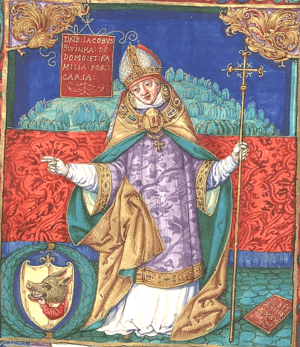
A few days after Ludgarda's funeral, Jakub Świnka became the Archbishop of Gniezno. This was a very important event for Poland. Archbishop Jakub Świnka became a close ally of Przemysł II. He supported the Duke's plans to unite Poland and even allowed him to mint his own coins.
Second Marriage
In 1285, Przemysł II married again. His new wife was Richeza, daughter of the former King of Sweden. The wedding took place in Sweden.
Alliances and Fatherhood
Przemysł II continued to build alliances. In 1285, Archbishop Jakub of Gniezno confirmed the excommunication of Henryk IV Probus, Przemysł II's opponent. Przemysł II also met with other dukes to discuss political matters.
On September 1, 1288, Przemysł II and Richeza had their first and only child, a daughter named Richeza. She later became queen of Bohemia and Poland. Duchess Richeza died sometime after her daughter's birth, before April 1293. Przemysł II seemed to care deeply for her. He named their daughter after her and even made a special gift to the church to keep a lamp lit forever at her tomb.
Conflict in Lesser Poland
When Duke Leszek II the Black of Kraków died in 1288 without children, a war broke out in Lesser Poland. Different groups supported different dukes. Henryk IV Probus was one of the main contenders. Surprisingly, Przemysł II joined an alliance against Henryk IV Probus. Their forces won a bloody battle in Siewierz in February 1289. After the battle, Przemysł II made a separate peace with Henryk IV Probus.
Rise to Kingship
Gaining Kraków
On June 23, 1290, Henryk IV Probus died. In his will, he left the Duchy of Kraków to Przemysł II, along with the title of High Duke of Poland. This was a big surprise. It's believed that Archbishop Jakub Świnka might have influenced this decision.
Przemysł II quickly took control of Kraków. He used a crowned eagle as his symbol, which was a sign of royal power. However, he never fully controlled the Duchy of Sandomierz, which was also part of the inheritance, as Władysław I the Elbow-high had already taken it.
Leaving Lesser Poland
Przemysł II left Kraków between September and October 1290 and never returned. He took the royal crown and other royal items with him, planning his own coronation.
Meanwhile, King Wenceslaus II of Bohemia wanted Lesser Poland. He had strong claims and a powerful army. Przemysł II realized he couldn't win a military fight against Wenceslaus II. So, he decided to give up his rights to Lesser Poland in exchange for money. Wenceslaus II took control of Kraków in April 1291.
Alliance with Henry III of Głogów
After losing Lesser Poland, Przemysł II formed a close alliance with Henry III, Duke of Głogów. They likely agreed that Henry III would inherit Greater Poland if Przemysł II died without a son.
The Congress of Kalisz
In January 1293, Przemysł II met with Władysław I the Elbow-high and Casimir II of Łęczyca in Kalisz. They formed an anti-Bohemian alliance. They agreed that if Kraków was recovered, Przemysł II would rule first, then Władysław, then Casimir. They also promised to help each other. Przemysł II also named Władysław the Elbow-high as his successor in Greater Poland if he died without male heirs.
Third Marriage
Around the time of the Kalisz meeting, Przemysł II married for the third time. His new wife was Margaret of Brandenburg, daughter of Albert III, Margrave of Brandenburg-Salzwedel. This marriage was for political reasons, meant to secure his rule over Pomerelia.
Inheriting Pomerelia
In 1294, Duke Mestwin II of Pomerelia died. As agreed in the Treaty of Kępno, Przemysł II inherited Pomerelia. This greatly increased his power. He then adopted the new title "Duke of Poland and Pomerania."
King of Poland
The Coronation
With Greater Poland and Gdańsk Pomerania united, Przemysł II became the strongest Polish ruler. He and Archbishop Jakub of Gniezno decided it was time for his coronation. This was a big step towards uniting all of Poland.
Przemysł II and his wife Margaret were crowned King and Queen of Poland on Sunday, June 26, 1295, at Gniezno Cathedral. It was the first Polish coronation in 219 years. Many important church leaders attended. The Pope's direct approval wasn't strictly needed because Poland was already recognized as a kingdom from earlier coronations.
The coronation of Przemysł II was seen as a revival of the old Kingdom of Poland. His royal seal even said, "He himself restored the victorious signs to the Poles."
Royal Rule and Assassination
After his coronation, Przemysł II traveled to Pomerelia, visiting important cities like Gdańsk and Słupsk. This showed how important Pomerelia was to his new kingdom.
On February 8, 1296, King Przemysł II was murdered. He was in Rogoźno for the Carnival celebrations. Sources disagree on who exactly was responsible. Some blame the Margraves of Brandenburg, while others point to Polish noble families like the Nałęcz and Zaremba families. Some sources suggest both groups were involved.
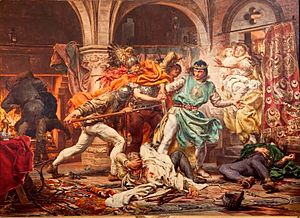
The most accepted story is that the Margraves of Brandenburg sent an army to kidnap him. They arrived early in the morning on February 8, Ash Wednesday, when the King's guards were asleep. Przemysł II resisted and was wounded. The attackers, unable to take him alive, killed him. A man named Jakub Kaszuba is often named as the direct killer. The King's body was left on the road near Rogoźno. The assassins were never caught.
Przemysł II was 39 years old when he died. He was buried in the Archcathedral Basilica of St. Peter and St. Paul in Poznań. His death was a big shock and led to new struggles for power in Poland.
Aftermath
Przemysł II was the last male ruler of the Greater Poland branch of the Piast dynasty. His death caused a quick scramble for power. Władysław I the Elbow-high and Henry III, Duke of Głogów fought over his lands. They eventually signed an agreement. Władysław the Elbow-high accepted Henry III's claim to Greater Poland, and Henry III's son was named as Władysław's heir.
The death of Przemysł II led to his kingdom being divided. However, Władysław I the Elbow-high's quick actions helped limit the losses to Brandenburg and other rivals.
Seals and Coins
Przemysł II used different seals during his reign to show his titles and power.
- His first seals showed a climbing lion, inherited from his father.
- Later, he used a seal with an eagle without a crown, and then a crowned eagle. The eagle was a symbol of the Piast dynasty and showed his claim to the Polish throne.
- After his coronation, his royal seal showed him sitting on a throne, wearing a crown, and holding royal symbols. The inscription on this seal highlighted his new title as King of Poland.
Historians are not sure which specific coins were minted by Przemysł II. However, it is known that he had the right to mint coins, and some coins from his time might have been made under his rule.
Economic Policy
Przemysł II worked closely with the Roman Catholic Church, especially with Archbishop Jakub Świnka. He gave the Archbishop the right to mint his own coins, which helped the Archbishop's economic power. He also supported other bishops and monasteries, like the Cistercians and Benedictines, by granting them land and privileges.
Przemysł II also helped the middle class and merchants.
- In 1280, Poznań, his capital, gained rights to lands and income.
- In 1283, merchants were freed from some taxes.
- In 1283, he extended town privileges to all cities in Greater Poland, based on the model of Kalisz.
- He granted special rights to the Jewish community in one village for a cemetery.
- He supported specific trades, like cloth sellers, and granted exemptions from customs duties to certain towns.
- He allowed cities like Rogoźno and Słupca to use German law, which helped them develop.
See also
 In Spanish: Premislao II de Polonia para niños
In Spanish: Premislao II de Polonia para niños
- History of Poland (966–1385)
- Dukes of Greater Poland
- Jakub Świnka
- Royal coronations in Poland
|
Przemysł II
Born: 14 October 1257 Died: 8 February 1296 |
||
| Regnal titles | ||
|---|---|---|
| Preceded by Bolesław the Pious |
Duke of Poznań 1273–1296 |
Succeeded by Władysław I the Elbow-high |
| Duke of Greater Poland, Kalisz, and Gniezno 1279–1296 |
||
| Duke of Wieluń 1279–1281 |
Succeeded by Henryk IV Probus |
|
| Preceded by Henryk IV Probus |
Duke of Wieluń 1287–1296 |
Succeeded by Władysław I the Elbow-high |
| High Duke of Poland 1290–1291 |
Succeeded by Wenceslaus II of Bohemia |
|
| Preceded by Bolesław II the Generous |
King of Poland 1295–1296 |
|
| Preceded by Mestwin II |
Duke of Pomerelia 1294–1296 |
Succeeded by Leszek of Inowrocław |


